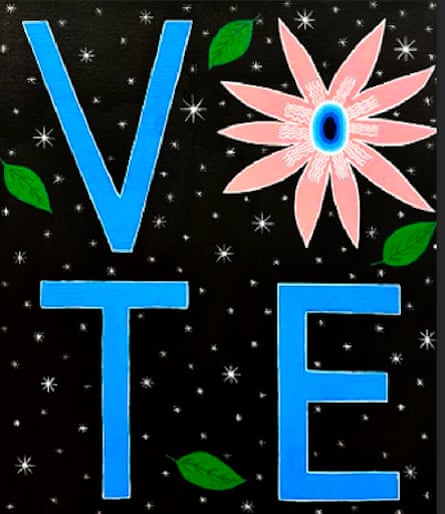Everything is politics, so the saying goes, and never more so during an election year. With its newest collection, Art for Change is taking the “everything” one step further.
Since 2018, Art for Change has curated programs of online sales and exhibitions to raise money for a number of charities. Ahead of the 2024 presidential election, Art for Change has partnered with When We All Vote, a non-partisan non-profit founded by Michelle Obama that seeks to up voter participation.
On their own, many of the pieces in this collection may not feel overtly political. An art novice would probably imagine a collaboration like this to include art similar to the red, white and blue of Shepard Fairey’s Hope and We The People posters – not Jordan Kasey’s surreal illustration of a baby and mother, Daniel Gordon’s still life of red apples and white poppies, or Aaron Johnson’s vivid auroral depiction of a couple with a bird flying from one’s heart.
But interspersed with pieces like Caris Reid’s playful rendering of the word “VOTE” against a starry backdrop and Rico Gatson’s colorful celebration of Shirley Chisholm, the first Black woman elected to Congress, each piece in this collection takes on new context. Especially under the mission statement of When We All Vote, which will receive a portion of all the sales of prints and original works, the artwork of this collection come together to show what’s at stake with each election – what exactly a person risks losing by choosing not to vote.
“The When We All Vote collection as a whole creates a narrative that we hope evokes various nuances of America,” said Jeanne Masel, founder of Art for Change. “As a group, they convey a sense of Americana, from the image of an apple to a whimsical take on a ‘Vote’ poster, to abstractions that evoke raw emotions.”
Masel added: “What I love about this collection is how varied and multivalent it is, which I think can also be read as reflecting our country’s diversity.”
Johnson completed Oh My Heart in 2023 and had not originally intended for it to convey a political message. “My piece can be looked at as kind of a love story,” he said. “It’s a coming together of two figures, melded together into like a non-duality.”
As part of this collection, the love story of Oh My Heart comes to represent the ties that hold us together. “In a lot of times in my work, I’m thinking about the interconnectedness of all beings, our interconnectivity with each other as humans or interconnectivity with nature,” Johnson said. “I think that all wraps back around to the idea of community and the idea of why of it’s important to vote, having empathy for others and having a sense of a shared community. I feel like that’s a message that runs kind of kind of parallel to what we’re looking for when we’re going to vote. How do we function together as good citizens? How do we take care of each other as citizens?”
Like Johnson, Kenny Rivero’s body of work, which looks at architecture and outdoor street space as sentient observers of our daily lives, does not always translate into something political. But once he agreed to work with Art for Change for this collaboration, he thought of Witness Revelator, a painting he finished in 2020 of a Black individual emerging from a dark rectangular portal in a gray brick wall. The witness in Witness Revelator is “a witness to your vote”, Rivero said.
“There’s a lot of things that we do alone, that we do intimately and in private and in secret, and I think voting is one of those things, especially now where everything is so polarized,” he said. “There’s this thing you’re doing that is private but you’re being tallied in something greater, something much more impactful. Witness Revelator, for me, is connected to that in the way of somebody witnessing the effort that you’re making to create progress or create change.”
Since its start six years ago, Art for Change has raised more than $300,000 for nonprofit partners and has collaborated with more than 100 artists, all of whom are guaranteed 50% of the profits from sales. Masel describes Art for Change as “art for the socially conscious collector”, but also a way for artists to have a platform for social change. “We invest in artists as changemakers,” she said.
This collection is the second time Rivero has worked with Art for Change, in part because he said he believes that artists have a unique role in a democracy, no matter the subject matter or intended message of their work.
“I think that artists are on the frontlines of creating new ideas on how to relate to each other,” Rivero said. “Because we’re constantly engaging with these ideas around family, community and relationships, so I think that we look to artists, not necessarily on how to rebuild society, but to tell us what’s wrong with it. Where does it hurt?”
Art for Change collaborated with When We All Vote for the 2020 election, working with four artists to raise more than $30,000 for the non-profit. This year, 14 artists are participating, with Art for Change pledging to donate a guaranteed $10,000.
“A visual medium has the power to drive social change and impact, and having these artists involved and spreading the word to get out and vote is so important,” Masel said. “This project really harnesses a great creativity and joy to inspire change.”

